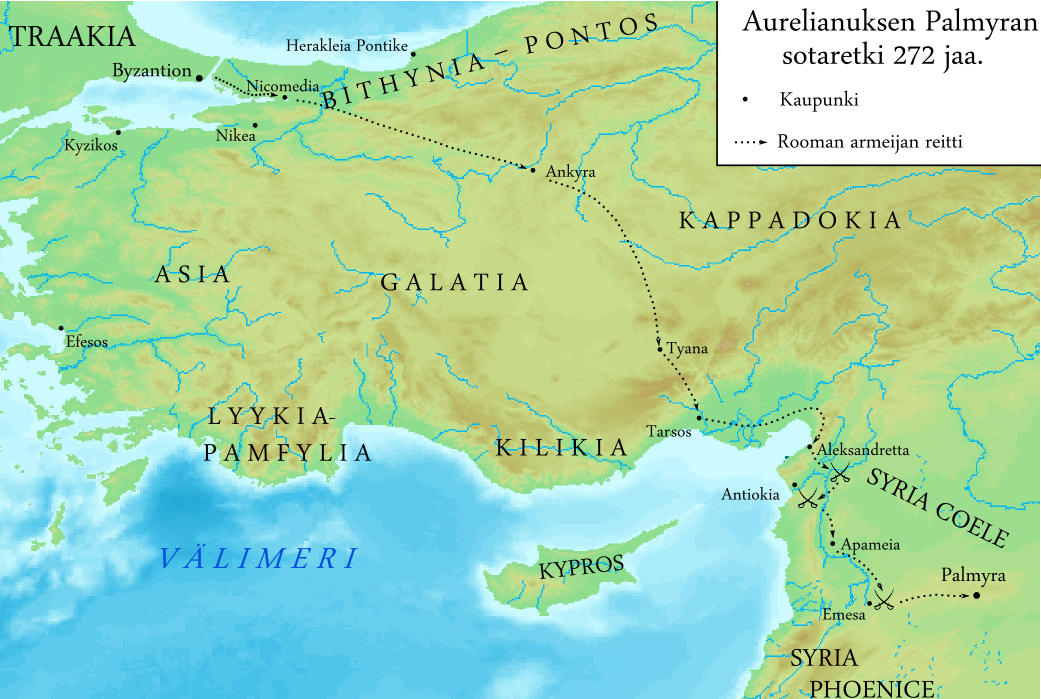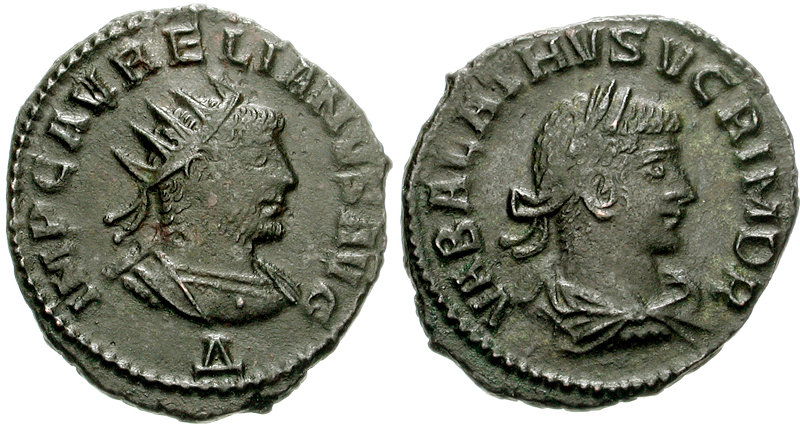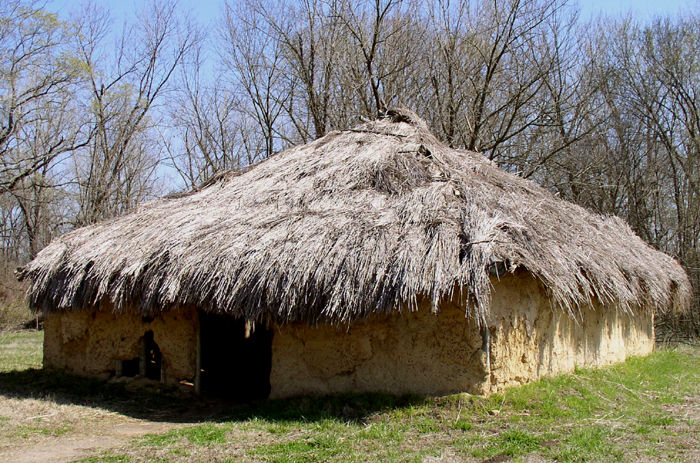|
Aurelian
Aurelian (; ; 9 September ) was a Roman emperor who reigned from 270 to 275 AD during the Crisis of the Third Century. As emperor, he won an unprecedented series of military victories which reunited the Roman Empire after it had nearly disintegrated under the pressure of barbarian invasions and internal revolts. Born in modest circumstances, most likely in Moesia, Moesia Superior, he entered the Roman army in 235 and climbed up the ranks. He went on to lead the cavalry of the emperor Gallienus, until Gallienus' Gallienus#Assassination, assassination in 268. Following that, Claudius Gothicus became emperor until his own death in 270. Claudius' brother Quintillus then ruled for three months, before Aurelian took the empire for himself. Aurelian was chosen Roman emperor by the Illyrians, Illyriciani as one of themselves. During his reign, he defeated the Alamanni after a devastating war. He also defeated the Goths, Vandals, Juthungi, Sarmatians, and Carpi (people), Carpi. Aurelian ... [...More Info...] [...Related Items...] OR: [Wikipedia] [Google] [Baidu] |
Ulpia Severina
Ulpia Severina was Roman empress as the wife of Roman emperor Aurelian from 270 to 275. Severina is unmentioned in surviving literary sources and known only from coinage and inscriptions, and as a result, very little is known about her. Her Ulpia gens, Ulpia suggests that she may have been related either to Emperor Trajan (r. 98–117) or the usurper Laelianus (r. 269), as they share the same nomen, and perhaps from Dacia, where the name was common. It is not known when she married Aurelian, but it might have been before he became emperor. She was probably proclaimed in the autumn of 274. Aurelian was murdered in September/October 275 and his successor, Tacitus (emperor), Tacitus, was proclaimed emperor only after a brief interregnum, lasting somewhere between five and eleven weeks. Though coins of Severina were minted under Aurelian from 274 to 275, some historians speculatively assign certain unusual types of coins to this brief interregnum period and suggest that Severina ei ... [...More Info...] [...Related Items...] OR: [Wikipedia] [Google] [Baidu] |
Palmyrene Empire
The Palmyrene Empire was a short-lived breakaway state from the Roman Empire resulting from the Crisis of the Third Century. Named after its capital city, Palmyra, it encompassed the Roman provinces of Syria Palaestina, Arabia Petraea, and Egypt (Roman province), Egypt, as well as large parts of Anatolia, Asia Minor. The Palmyrene Empire was ruled by Queen Zenobia, officially as regent for her son Vaballathus, who inherited the throne in 267 at age ten. In 270, Zenobia rapidly conquered most of the Roman east, attempting to maintain relations with Rome as a legitimate power. In 271, she claimed the imperial title for both herself and her son, fighting a short war with the Roman emperor Aurelian, who conquered Palmyra and captured Zenobia. A year later the Palmyrenes rebelled, which led Aurelian to raze Palmyra. Despite its brief existence, the Palmyrene Empire is remembered for having been ruled by one of the most ambitious and powerful women in antiquity. It is also hailed in mo ... [...More Info...] [...Related Items...] OR: [Wikipedia] [Google] [Baidu] |
Crisis Of The Third Century
The Crisis of the Third Century, also known as the Military Anarchy or the Imperial Crisis, was a period in History of Rome, Roman history during which the Roman Empire nearly collapsed under the combined pressure of repeated Barbarian invasions into the Roman Empire of the 3rd century, foreign invasions, List of Roman civil wars and revolts, civil wars and Economic collapse, economic disintegration. At the height of the crisis, the Roman state split into three distinct and competing polities. The period is usually dated between the death of Severus Alexander (235) and accession of Diocletian (284). The crisis began in 235 with the assassination of Emperor Severus Alexander by his own troops. During the following years, the empire saw Barbarian invasions of the 3rd century, barbarian invasions and Human migration, migrations into Roman territory, civil wars, bagaudae, peasant rebellions and political instability, with multiple Roman usurper, usurpers competing for power. This led ... [...More Info...] [...Related Items...] OR: [Wikipedia] [Google] [Baidu] |
Aurelian Walls
The Aurelian Walls () are a line of city walls built between 271 AD and 275 AD in Rome, Italy, during the reign of the Roman Emperor Aurelian. They superseded the earlier Servian Wall built during the 4th century BC. The walls enclosed all the seven hills of Rome plus the Campus Martius and, on the right bank of the Tiber, the Trastevere district. The river banks within the city limits appear to have been left unfortified, although they were fortified along the Campus Martius. The size of the entire enclosed area is . The wall cut through populated areas: in reality the city at the time embraced . Pliny the Elder in the first century AD suggested that the densely populated areas, ''extrema tectorum'' ("the limits of the roofed areas") extended from the Golden Milestone in the Forum (Natural History 3.67). Construction The full circuit ran for surrounding an area of . The walls were constructed in brick-faced concrete, thick and high, with a square tower every 100 Roman fe ... [...More Info...] [...Related Items...] OR: [Wikipedia] [Google] [Baidu] |
Roman Dacia
Roman Dacia ( ; also known as ; or Dacia Felix, ) was a province of the Roman Empire from 106 to 271–275 AD. Its territory consisted of what are now the regions of Oltenia, Transylvania and Banat (today all in Romania, except the last region which is split among Romania, Hungary, and Serbia). During Roman rule, it was organized as an imperial province on the borders of the empire. It is estimated that the population of Roman Dacia ranged from 650,000 to 1,200,000. It was conquered by Trajan (98–117) after two campaigns that devastated the Dacian Kingdom of Decebalus. However, the Romans did not occupy its entirety; Crișana, Maramureș, and most of Moldavia remained under the Free Dacians. After its integration into the empire, Roman Dacia saw constant administrative division. In 119 under Hadrian, it was divided into two departments: Dacia Superior ("Upper Dacia") and Dacia Inferior ("Lower Dacia"; later named Dacia Malvensis). Between 124 and around 158, Dacia Sup ... [...More Info...] [...Related Items...] OR: [Wikipedia] [Google] [Baidu] |
Sol Invictus
Sol Invictus (, "Invincible Sun" or "Unconquered Sun") was the official Solar deity, sun god of the late Roman Empire and a later version of the god Sol (Roman mythology), Sol. The emperor Aurelian revived his cult in 274 AD and promoted Sol Invictus as the chief god of the empire. From Aurelian onward, Sol Invictus often appeared on imperial coinage, usually shown wearing a sun crown and driving a horse-drawn chariot through the sky. His prominence lasted until the emperor Constantine the Great, Constantine I legalized Christianity and restricted paganism. The last known inscription referring to Sol Invictus dates to AD 387, although there were enough devotees in the fifth century that the Christian theologian Augustine of Hippo, Augustine found it necessary to preach against them. In recent years, the scholarly community has become divided on Sol between traditionalists and a growing group of revisionists. In the traditional view, ''Sol Invictus'' was the second of two dif ... [...More Info...] [...Related Items...] OR: [Wikipedia] [Google] [Baidu] |
Dacia Ripensis
Dacia Ripensis () was the name of a Roman province in the northern Balkan peninsula, immediately south of the Middle Danube. Its capital was Ratiaria (modern Archar, Bulgaria). It was a district less urban than neighbouring Dacia Mediterranea and more militarized; "military camps and forts, rather than cities, were typical of the province". Besides Ratiaria, Oescus was the major settlement. Dacia Ripensis was one of the "Two Dacias" established south of the Danube in the late 3rd century. The Roman emperor Aurelian () abandoned the province of Roman Dacia established by Trajan () in 106 AD on the northern bank of the river, and created the two new "Dacias" between the existing provinces of Moesia Prima (upstream) and Moesia Secunda (downstream). The northern part of Aurelian's Dacia Aureliana is attested as "Dacia Ripensis" in 343/4. The southern part, with its capital at Serdica (modern Sofia) was known as Dacia Mediterranea. According to the ''Laterculus Veronensis'', b ... [...More Info...] [...Related Items...] OR: [Wikipedia] [Google] [Baidu] |
Caenophrurium
Caenophrurium (also written as Cenophrurium and Coenophrurium; ) was a settlement in the Roman province of Europa (the southeasternmost part of Thrace), between Byzantium and Heraclea Perinthus. It appears in late Roman and early Byzantine accounts. Caenophrurium translates as the "stronghold of the Caeni", a Thracian tribe. Location Classical scholars have at times identified various towns in Thrace as corresponding to Caenophrurium. Recent scholarship locates Caenophrurium near the modern Turkish village of Sinekli, in Silivri district, Istanbul Province. The '' Barrington Atlas'' includes Caenophrurium as one of 24 ''komes'' (towns) and ''choria'' (villages) in the province of Europa. These were smaller settlements than the 14 cities of the province listed by Hierocles in his ''Synecdemus'' (c. 527–528): the provincial capital ( Heraclea Perinthus) and 13 others. Some confusion as to the exact location of Caenophrurium appears to derive from the fact that references to ... [...More Info...] [...Related Items...] OR: [Wikipedia] [Google] [Baidu] |
Tacitus (emperor)
Marcus Claudius Tacitus ( ; died June 276) was Roman emperor from 275 to 276. During his short reign he campaigned against the Goths and the Heruli, for which he received the title ''Gothicus Maximus''. Early life His early life is largely unknown. An origin story circulated after his coronation claimed Tacitus to be the heir of an old Umbrian family and one of the wealthiest men of the empire, with a total wealth of 280 million sestertii. His faction distributed copies of the historian Publius Cornelius Tacitus' work, which was barely read at the time, perhaps contributing to its partial survival. Modern historiography rejects his alleged descent from the historian as a fabrication. It is more likely that he emerged from the Illyrian military, which made him a representative of the army in imperial politics. In the course of his long life he held various civil offices, including the consulship twice, once under Valerian and again in 273, earning universal respect. Emperor A ... [...More Info...] [...Related Items...] OR: [Wikipedia] [Google] [Baidu] |
Historia Augusta
The ''Historia Augusta'' (English: ''Augustan History'') is a late Roman collection of biographies, written in Latin, of the Roman emperors, their junior colleagues, Caesar (title), designated heirs and Roman usurper, usurpers from 117 to 284. Supposedly modeled on the similar work of Suetonius, ''The Twelve Caesars'', it presents itself as a compilation of works by six different authors, collectively known as the ''Scriptores Historiae Augustae'', written during the reigns of Diocletian and Constantine I and addressed to those emperors or other important personages in Ancient Rome. The collection, as extant, comprises thirty biographies, most of which contain the life of a single emperor, but some include a group of two or more, grouped together merely because these emperors were either similar or contemporaneous. The true authorship of the work, its actual date, its reliability and its purpose have long been matters for controversy by historians and scholars ever since Hermann ... [...More Info...] [...Related Items...] OR: [Wikipedia] [Google] [Baidu] |
Claudius Gothicus
Marcus Aurelius Claudius "Gothicus" (10 May 214 – August/September 270), also known as Claudius II, was Roman emperor from 268 to 270. During his reign he fought successfully against the Alemanni and decisively defeated the Goths at the Battle of Naissus. He died after succumbing to a "pestilence", possibly the Plague of Cyprian that had ravaged the provinces of the Empire. Early life and origin The most significant source for Claudius II (and the only one regarding his early life) is the collection of imperial biographies called the ''Historia Augusta''. However, his story, like the rest of the ''Historia Augusta'', is riddled with fabrications and obsequious praises. In 4th century, Claudius was declared a relative of Constantine the Great's father, Constantius Chlorus, and, consequently, of the ruling dynasty. The ''Historia Augusta'' should be used with extreme caution and supplemented with information from other sources: the works of Aurelius Victor, Pseudo-Aurelius ... [...More Info...] [...Related Items...] OR: [Wikipedia] [Google] [Baidu] |
Carpi (people)
The Carpi or Carpiani were a tribe that resided in the eastern parts of modern Romania in the historical region of Moldavia from no later than c. AD 140 and until at least AD 318. The ethnic affiliation of the Carpi remains disputed, as there is no direct evidence in the surviving ancient literary sources. A strong body of modern scholarly opinion considers that the Carpi were a tribe of the Dacian nation. Other scholars have linked the Carpi to a variety of ethnic groups, including Sarmatians, Thracians, Slavs, Germanic peoples, Balts and Celts. About a century after their earliest mention by Ptolemy, during which time their relations with Rome appear to have been peaceful, the Carpi emerged in c. 238 as among Rome's most persistent enemies. In the period AD 250–270, the Carpi were an important component of a loose coalition of transdanubian barbarian tribes that also included Germanic and Sarmatian elements. These were responsible for a series of large and devastating inva ... [...More Info...] [...Related Items...] OR: [Wikipedia] [Google] [Baidu] |











